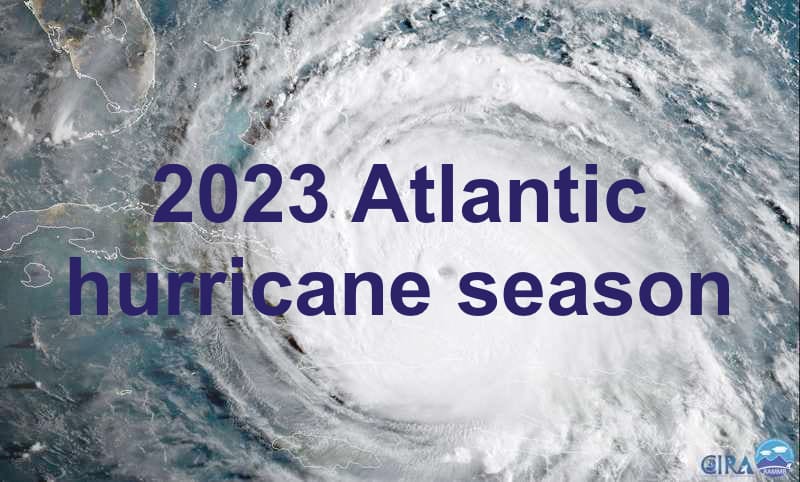Hurricane forecasts point to US and Florida risk for 2023 season

Two additional hurricane forecasts have been released that both suggest that the United States eastern seaboard and Florida could face elevated threats this year, the main reason being the warmer than average SST’s seen in the Atlantic and also Gulf.
Yes, the expectation is for this to be an El Niño year, but rarely have Atlantic sea surface temperatures SST’s been so warm when transitioning from La Nina to El Niño.
As a result, Accuweather and Weatherbell both opt for roughly average storm numbers in their forecasts, but each highlight the potential threat to the US and Florida during the 2023 Atlantic hurricane season.
Accuweather meteorologists say that Florida will once again be at risk for land-falling tropical systems during this year’s hurricane season.
They forecast a less active season than most since 1995, calling for the 2023 season to be near the historical average with 11-15 named tropical storms, Four to eight of which are expected to reach hurricane strength, and one to three achieving major hurricane status.
“We are also projecting two to four direct impacts on the United States, including Puerto Rico and the Virgin Islands,” said Senior Meteorologist and Hurricane Expert Dan Kottlowski.
“Based on climatology and an evolving El Niño pattern during August through October, the highest chance for direct and significant impacts will be from the Florida Panhandle around the entire state of Florida to the Carolina coast,” Kottlowski added. “There appears to be a lower chance for direct impacts over the western Gulf of Mexico and for the Northeast U.S.”
Kottlowski’s team point to above-normal SST’s and also the strength of the Bermuda high, as storylines to monitor throughout the season this year.
Warm waters in the Gulf of Mexico and off the southeast US coast are also capable of pre-season tropical system development, the Accuweather forecast team states.
“Even if this season were to turn out to be less active than normal, abundant warm water could lead to the development of a couple of very strong hurricanes, as we saw with Ian,” Kottlowski explained. “Anyone living near or at the coast must have a hurricane plan in place to deal with what could be a life-threatening or very damaging hurricane. Now is the time to create or update your plan.”
Meanwhile, forecaster Weatherbell believes that warmer SST’s in the Atlantic could throw up some surprises for the US as well, with waters warm enough away from the main development region (MDR) to support storm formation.
Weatherbell calls for 10 to 14 named storms, 5 to 7 hurricanes and 2 to 3 major hurricanes for the 2023 Atlantic season, but also forecasts US impacts of 5 occurrences of tropical storm conditions, 3 of hurricane conditions, and 1 of major hurricane conditions.
The team at Weatherbell led by Joe Bastardi point to the chance of this year being particularly unusual due to the developing El Niño and the fact the Atlantic remains very warm.
“This year could be a classic example. It will feature a potentially top-10 El Niño versus a warm Atlantic. How much oxygen the El Niño can suck out of the room is not a normal slam dunk,” Bastardi explained.
Continuing, “I am confident of a below average season for Central America and the Caribbean. A lot of the African wave energy may be left in the form of storms to the east of 50°W that recurve.
“The fear is a feeding frenzy near our coasts with in-close development. As long as the Atlantic is warm that will always be a concern, but an El Niño is no cause for relaxation.”
2023 could be a unique El Niño year, Bastardi believes, with the strength of it and the warm SST’s potentially making this different to other El Niño years.
“My take is that the Atlantic is warm enough that the farther away from the Main Development Region the more the chance for development relative to normal. That means the U.S. is in an area close to it,” Bastardi concludes.
Both of these forecasters have highlighted factors that will need watching as the insurance, reinsurance and insurance-linked securities (ILS) markets position themselves for the coming season.
It’s a reminder that just because the forecasts are for average levels of activity, it does not mean the impacts will be less severe. Activity levels do not equal landfalls and as a result economic and insurance market losses. It is storm location, intensity, the values exposed, and other factors, that drive losses reinsurance and ILS markets need to be concerned about.
As a result, uncertainty related to El Nino and higher SST’s that can drive formation of storms in less-typical locations, are all factors that will require study as the season progresses this year.
Track the 2023 Atlantic tropical storm and hurricane season on our dedicated page and we’ll update you as new information emerges.






